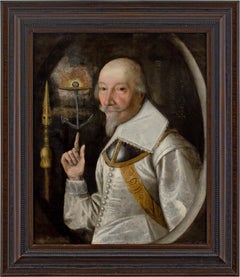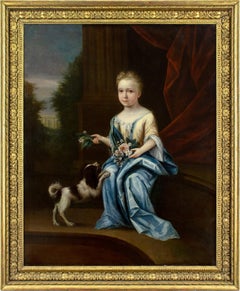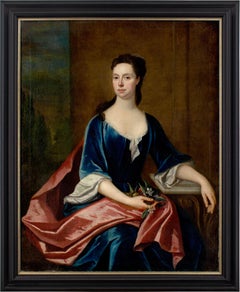Want more images or videos?
Request additional images or videos from the seller
1 of 13
Jacob Huysmans (Attributed), Portrait Of A Lady With Pearlsc. 1665
c. 1665
$9,828.77List Price
About the Item
- Attributed to:Jacob Huysmans (1633 - 1696, Flemish)
- Creation Year:c. 1665
- Dimensions:Height: 37 in (93.98 cm)Width: 32 in (81.28 cm)Depth: 2 in (5.08 cm)
- Medium:
- Movement & Style:
- Period:Mid-17th Century
- Condition:Cleaned. Revarnished. Canvas relined. One faint stretcher imprint. Fine craquelure throughout. The paint layer is stable. Later stretcher. Frame in good condition with minor age-related wear.
- Gallery Location:Cheltenham, GB
- Reference Number:1stDibs: LU2328216790672
About the Seller
5.0
Platinum Seller
Premium sellers with a 4.7+ rating and 24-hour response times
Established in 2017
1stDibs seller since 2023
246 sales on 1stDibs
Authenticity Guarantee
In the unlikely event there’s an issue with an item’s authenticity, contact us within 1 year for a full refund. DetailsMoney-Back Guarantee
If your item is not as described, is damaged in transit, or does not arrive, contact us within 7 days for a full refund. Details24-Hour Cancellation
You have a 24-hour grace period in which to reconsider your purchase, with no questions asked.Vetted Professional Sellers
Our world-class sellers must adhere to strict standards for service and quality, maintaining the integrity of our listings.Price-Match Guarantee
If you find that a seller listed the same item for a lower price elsewhere, we’ll match it.Trusted Global Delivery
Our best-in-class carrier network provides specialized shipping options worldwide, including custom delivery.You May Also Like
Old man elderly oil on board painting
Located in Sitges, Barcelona
Anonymous - Old man - Oil on board
Oil size 34x25 cm.
Frameless
Category
1920s Baroque Portrait Paintings
Materials
Canvas, Oil
Three Angels
By Domenico Piola the Elder
Located in New York, NY
Provenance:
Robert L. and Bertina Suida Manning, New York, until 1996
Private Collection, USA
One of the leading artists in Genoa during the second half of the seventeenth century, Domenico Piola came from a successful family of artists, renowned for their many illusionistic ceiling programs throughout Genoese churches and palaces. A prolific draughtsman and painter, Domenico oversaw an extremely productive studio. In addition to his collaborations with numerous other artists, Domenico also provided many designs for book illustrations and prints that circulated throughout Europe, earning him international exposure and high acclaim in his own day.
As Dr. Anna Orlando has indicated (written communication), the present work is an early work by Piola, datable from the late 1640s. At this time the young artist came strongly under the influence of Castiglione and Valerio Castello, while admiring the works of Giulio Cesare Procaccini. Piola’s works from this period are exuberant and fluid, and the artist’s love of portraying children is evident from the angels and putti that populate both his altarpieces and more intimate paintings.
The present work depicts three angels...
Category
17th Century Baroque Figurative Paintings
Materials
Canvas, Oil
Oil On Canvas Self Portrait of the artist Sir Anthony Van Dyck 18Th c
Located in Gavere, BE
"Oil On Canvas Self Portrait After Sir Anthony Van Dyck"
Follower of Sir Anthony van Dyck (Flemish painter, 1599-1641), Self portrait Oil on canvas (doubled),
Probably end 18th centu...
Category
Late 18th Century Baroque Figurative Paintings
Materials
Gold Leaf
$31,021
H 28.75 in W 25.2 in D 1.97 in
St. Peter and the Rooster Italian School 17th Century Oil Painting on Canvas
Located in Milano, IT
St. Peter And The Rooster 1600 oil painting on canvas reinteled with new frame. The painting was probably part of a larger composition depicting St. Peter repenting, weeping. Italian...
Category
Mid-17th Century Baroque Portrait Paintings
Materials
Canvas, Oil
$4,790
H 22.84 in W 22.45 in D 0.79 in
Neapolitan caravagist artist, 17th century SAINT THOMAS APOSTOLE
By Hendrick de Somer
Located in Tricase, IT
Neapolitan caravagist artist, 17th century
SAINT THOMAS APOSTOLE
oil on canvas, cm 127x101
(The painting is part of a triptych together with the two holy apostles Saint James the Mi...
Category
1620s Baroque Figurative Paintings
Materials
Canvas, Oil
Head of a Classical Poet (Socrates?)
By Pier Francesco Mola
Located in New York, NY
Provenance:
Possibly Antonio Amici Moretti, Rome, 1690
Roy Clyde Gardner, Union, Mississippi, 1970s until 2004; by whom given to:
Mississippi Band of Choctaw Indians, 2004-2010
Lit...
Category
17th Century Baroque Paintings
Materials
Canvas, Oil
"Virgen de la Almudena" Cusco Style Image of the Virgin Mary and Baby Jesus
By Martha Ochoa
Located in Austin, TX
By Martha Ochoa
Oil on Canvas
Canvas Size: 24" x 16"
Framed Size: 27" x 19.25"
This lovely painting by Martha Ochoa is from the Cusco tradition. The Cusco School was an artistic tra...
Category
1990s Baroque Paintings
Materials
Canvas, Oil
"The Virgen de Huápulo" Depiction of the Virgin Mary by Martha Ochoa
By Martha Ochoa
Located in Austin, TX
By Martha Ochoa
Oil on Canvas
Canvas Size: 23.75" x 15.75"
Framed Size: 27" x 19.25"
This lovely painting by Martha Ochoa is from the Cusco tradition. The Cusco School was an artist...
Category
1990s Baroque Paintings
Materials
Oil, Canvas
$2,950
H 23.75 in W 15.75 in
Dipinto ritratto femminile figurativo barocco emiliano del XVII secolo
By Girolamo Negri called Il Boccia
Located in Florence, IT
olio su tela, 62 x 51 cm (senza cornice)
Il dipinto è stato per lungo attribuito alla mano di Francesco Gessi, allievo di Guido Reni, come riporta un'iscrizione a matita datata 1945...
Category
Late 17th Century Baroque Figurative Paintings
Materials
Canvas, Oil
$6,827
H 30.32 in W 25.99 in
'Rebekah at the Well', Follower of Luca Giordano, Early 19th Century Figural Oil
Located in Santa Cruz, CA
An early 19th century, figural oil of a young woman with chestnut hair, shown wearing a headscarf and glancing towards the viewers left. Unsigned. A detail from a copy of 'Rebeca at ...
Category
19th Century Baroque Portrait Paintings
Materials
Canvas, Masonite, Oil
$3,750
H 16 in W 13.75 in D 0.13 in
More From This Seller
View AllEarly 17th-Century Dutch School, Portrait Of A Swedish Officer
Located in Cheltenham, GB
This heavily-inscribed early 17th-century half-length portrait depicts an officer wearing a silk doublet with a gorget, presented in a feigned oval. He’s standing alongside an anchor...
Category
17th Century Baroque Portrait Paintings
Materials
Canvas, Oil
John Verelst (Circle), Portrait Of A Young Lady With A Spaniel
By John Verelst
Located in Cheltenham, GB
This large early 18th-century full-length portrait depicts a seated young lady before a classical column and distant country house. It was formerly in the collection of Dalham Hall i...
Category
Early 18th Century Rococo Portrait Paintings
Materials
Canvas, Oil
Maria Verelst (Circle), Portrait Of Miss Richards
By Maria Verelst
Located in Cheltenham, GB
This charming early 18th-century three-quarter length portrait depicts a lady wearing a decolleté blue velvet dress with a slit in the bodice. Red fabric is draped around her, and sh...
Category
1720s Portrait Paintings
Materials
Canvas, Oil
Mid-19th-Century French School, A Pair Of Nanas, 2 x Oil Paintings
Located in Cheltenham, GB
This charming pair of mid-19th-century French School portraits depicts two grandmothers, both presumably widows, wearing black gowns and white bonnets.
Alas, the identity of these r...
Category
Mid-19th Century Portrait Paintings
Materials
Canvas, Oil
Early 19th-Century English School Portrait Of Samuel Jones Of Skeyton, Norfolk
Located in Cheltenham, GB
This fine early 19th-century English oil painting depicts Samuel Jones of Skeyton, Norfolk, smartly attired in a black coat with white cravat. The portrait was previously in the coll...
Category
1830s Portrait Paintings
Materials
Oil, Canvas
Mid-18th-Century French School, Portrait Of A Lady With Sapphires
Located in Cheltenham, GB
This charming mid-18th-century half-length French portrait depicts a lady wearing an olive green gown, together with a red cloak, and exquisite sapphi...
Category
Mid-18th Century Rococo Portrait Paintings
Materials
Oil, Canvas



